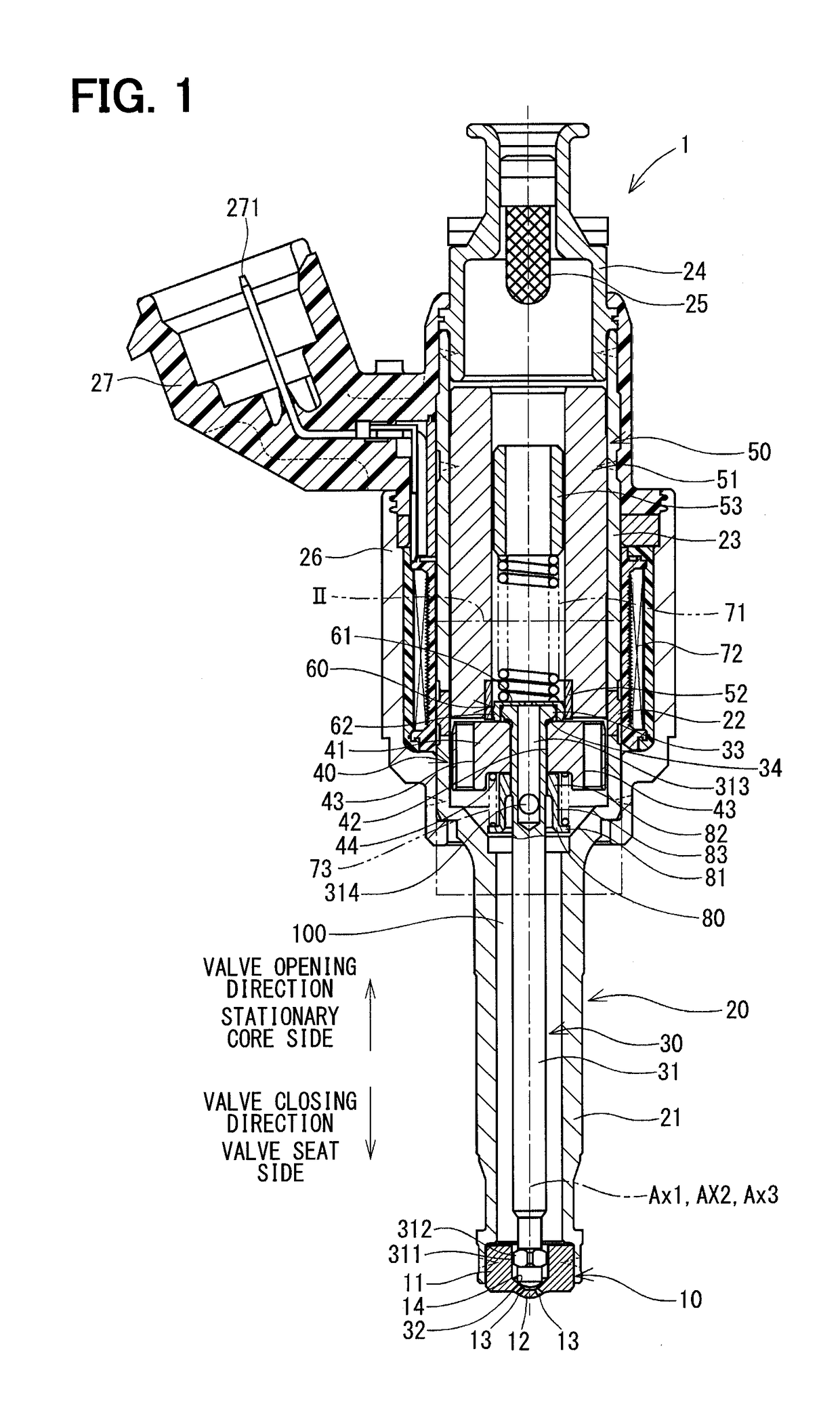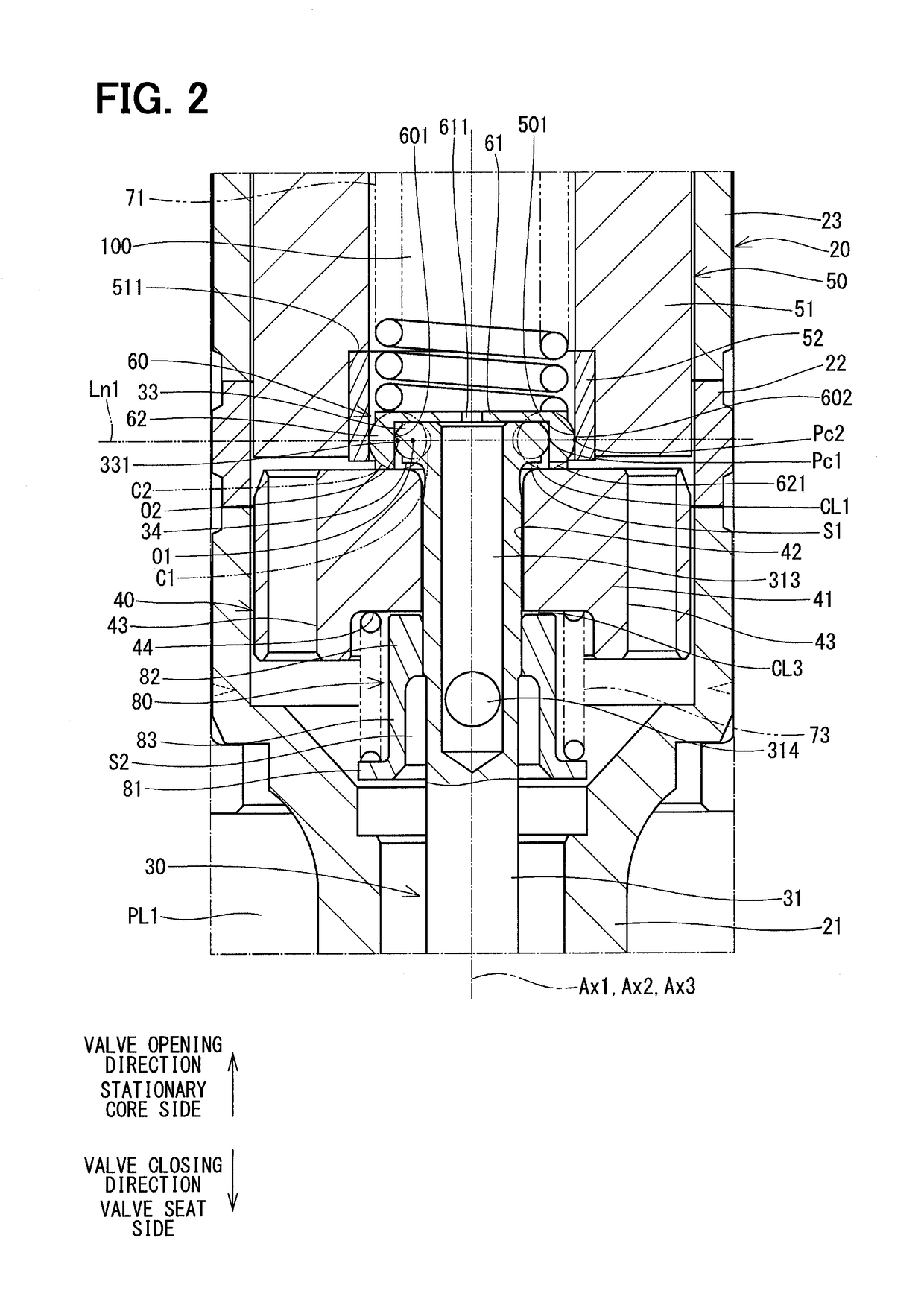Fuel injection device
- Summary
- Abstract
- Description
- Claims
- Application Information
AI Technical Summary
Benefits of technology
Problems solved by technology
Method used
Image
Examples
first embodiment
[0042]FIG. 1 shows a fuel injection device (a fuel injection valve) according to a first embodiment of the present disclosure. The fuel injection device 1 is used in, for example, an undepicted direct injection type gasoline engine (serving as an internal combustion engine) and injects gasoline as fuel in the engine.
[0043]The fuel injection device 1 includes a nozzle 10, a housing 20, a needle 30, a movable core 40, a stationary core 50, a gap forming member 60, a spring (serving as a valve seat side urging member) 71 and a coil 72.
[0044]The nozzle 10 is made of a material, such as martensitic stainless steel, which has a relatively high hardness. The nozzle 10 is quenched to have a predetermined hardness. The nozzle 10 includes a nozzle tubular portion 11 and a nozzle bottom portion 12 while the nozzle bottom portion 12 closes one end of the nozzle tubular portion 11. The nozzle bottom portion 12 has a plurality of injection holes 13, each of which connects between an inner surface...
second embodiment
[0121]FIG. 6 shows a portion of the fuel injection device according to a second embodiment of the present disclosure. The second embodiment differs from the first embodiment with respect to the shapes of the flange 33 and the gap forming member 60.
[0122]In the second embodiment, the flange outer wall surface 331 is formed along an entire axial extent of the outer wall of the flange 33 located on the radially outer side. Furthermore, the outer side wall surface 602 is formed along an entire axial extent of the outer wall of the gap forming member 60 located on the radially outer side such that the outer side wall surface 602 is opposed to the stationary core inner wall surface 501.
[0123]The center O1 of the first imaginary circle C1 and the center O2 of the second imaginary circle C2 are located along the imaginary straight line Ln1, which is perpendicular to the axis Ax1 of the housing 20, when the plate portion 61 is in contact with the needle 30. Furthermore, the center O1 of the ...
third embodiment
[0127]FIG. 7 shows a portion of the fuel injection device according to a third embodiment of the present disclosure. The third embodiment differs from the second embodiment with respect to the shape of the gap forming member 60.
[0128]In the third embodiment, the outer side wall surface 602 of the gap forming member 60 is formed into a cylindrical form. Furthermore, the outer diameter of the outer side wall surface 602 is set to be equal to the inner diameter of the stationary core inner wall surface 501 of the stationary core 50 or is set to be slightly smaller than the inner diameter of the stationary core inner wall surface 501. Therefore, the outer side wall surface 602 is slidable relative to the stationary core inner wall surface 501.
[0129]In the third embodiment, the rest of the structure, which is other than the above-described point, is the same as that of the second embodiment.
[0130]As discussed above, (1) in the present embodiment, the flange outer wall surface 331, which ...
PUM
 Login to View More
Login to View More Abstract
Description
Claims
Application Information
 Login to View More
Login to View More - R&D
- Intellectual Property
- Life Sciences
- Materials
- Tech Scout
- Unparalleled Data Quality
- Higher Quality Content
- 60% Fewer Hallucinations
Browse by: Latest US Patents, China's latest patents, Technical Efficacy Thesaurus, Application Domain, Technology Topic, Popular Technical Reports.
© 2025 PatSnap. All rights reserved.Legal|Privacy policy|Modern Slavery Act Transparency Statement|Sitemap|About US| Contact US: help@patsnap.com



